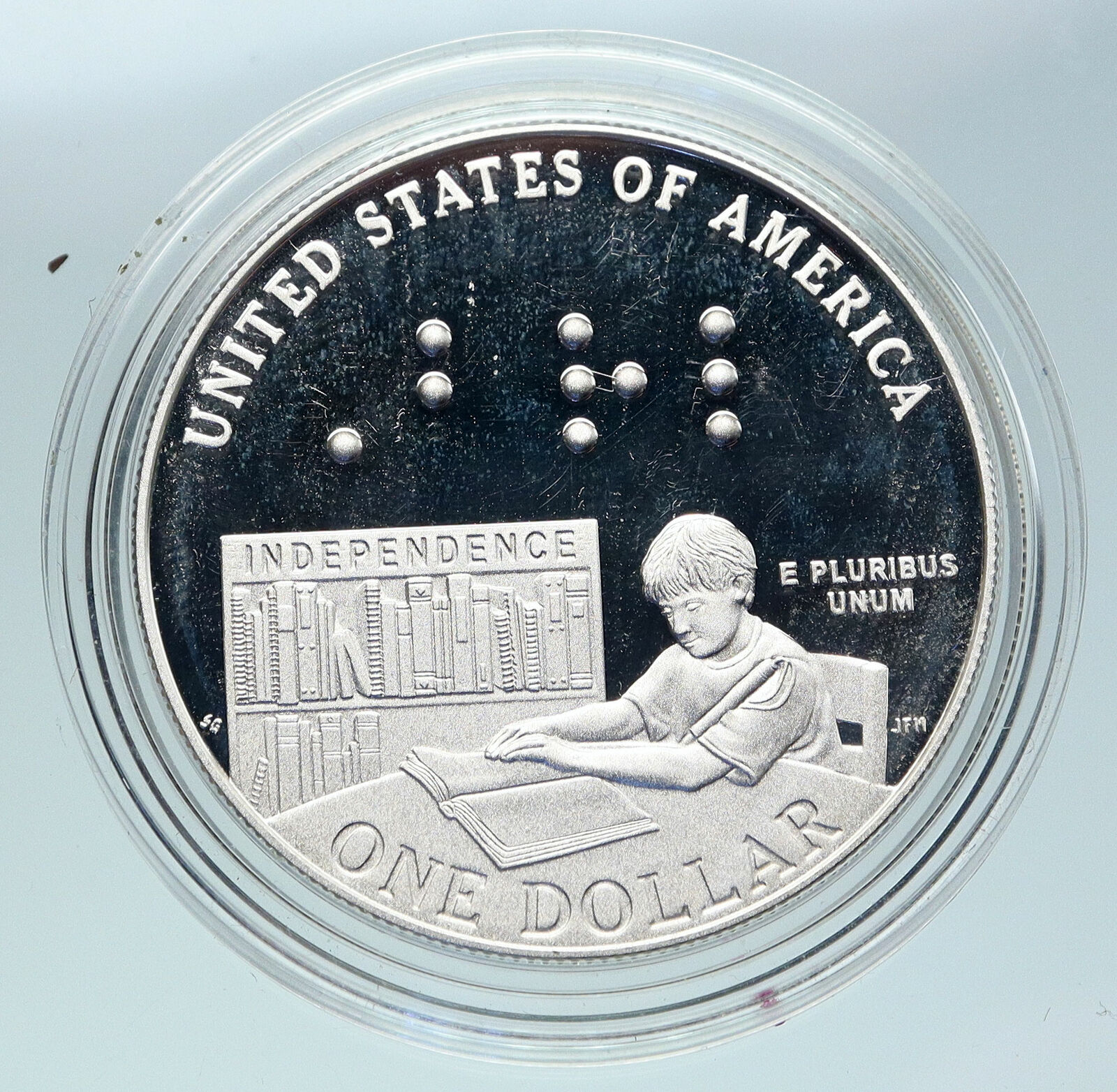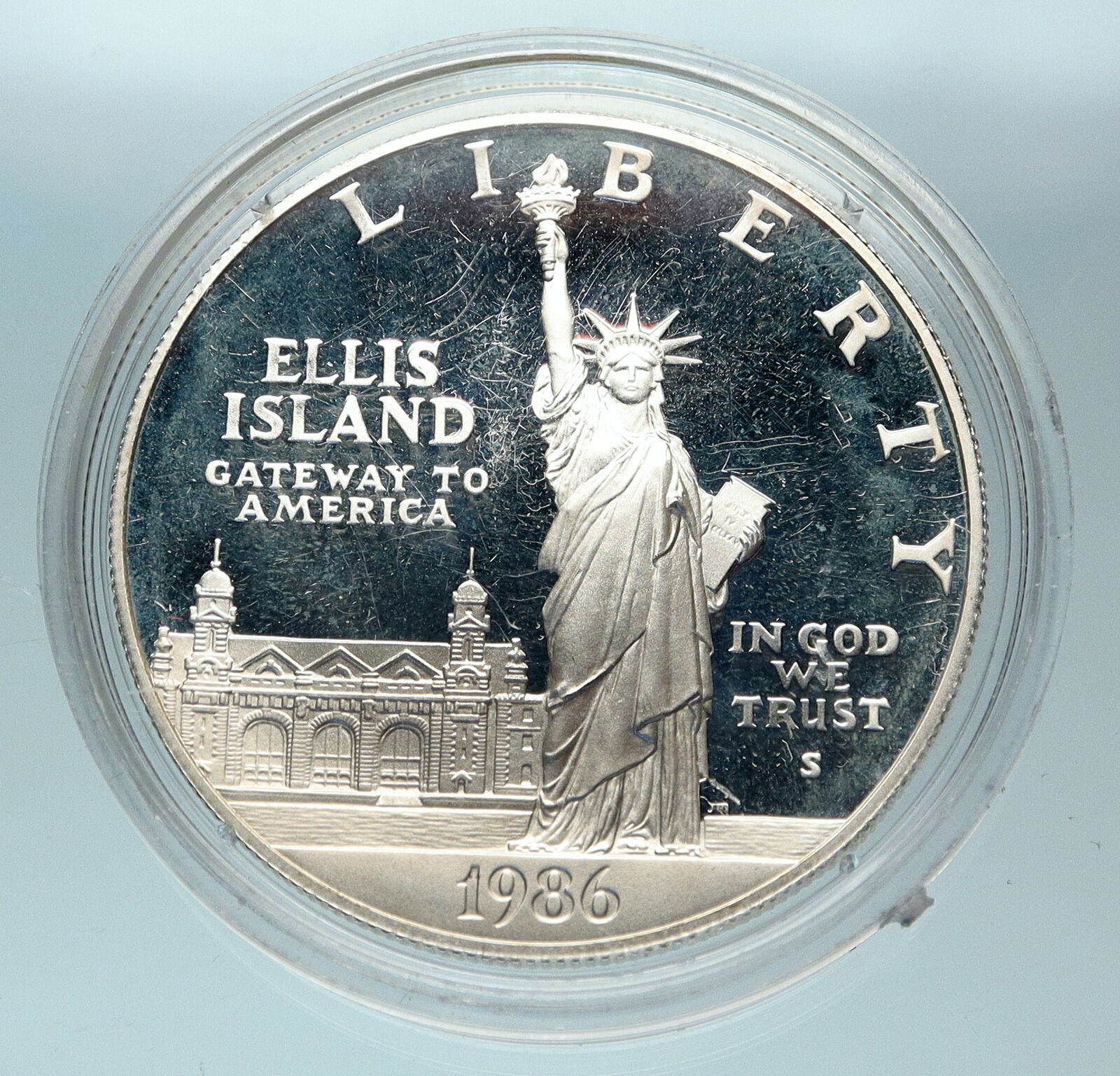|
United States of America – Eisenhower Centennial
1991 Proof Silver Dollar 38mm (26.73 grams) 0.900 Silver
Reference: KM# 227 | Engravers: John M. Mercanti, Marcel Jovine
EISENHOWER CENTENNIAL LIBERTY P IN GOD WE TRUST 1890-1990, Two profiles of Eisenhower. Profile facing right as 34th President superimposed over profile facing left as 5 Star General.
UNITED STATES OF AMERICA EISENHOWER HOME E PLURIBUS UNUM ONE DOLLAR CYM, Eisenhower home at Gettysburg National Historic Site.
Coin Notes:
The Eisenhower Silver Dollar was offered in proof and uncirculated versions with a maximum authorized mintage of 4 million coins. The uncirculated version of the coin was produced at the West Point Mint and the proof version at the Philadelphia Mint. Sales for the program were initially strong, with more than one million ordered within less than three months. After that point, the pace of sales slowed with the final number reaching 1.39 million by the conclusion of sales.
The coins were offered for sale individually, with the proof version also included in the 1990 Prestige Proof Set. Surcharges from the sale of the coins was used to reduce the public debt.
You are bidding on the exact item pictured, provided with a Certificate of Authenticity and Lifetime Guarantee of Authenticity.
 Dwight David “Ike” Eisenhower (/ˈaɪzənhaʊ.ər/ EYE-zən-how-ər; October 14, 1890 – March 28, 1969) was an American army general and statesman who served as the 34th President of the United States from 1953 to 1961. During World War II, he was a five-star general in the United States Army and served as Supreme Commander of the Allied Expeditionary Forces in Europe. He was responsible for planning and supervising the invasion of North Africa in Operation Torch in 1942-43 and the successful invasion of France and Germany in 1944-45 from the Western Front. Dwight David “Ike” Eisenhower (/ˈaɪzənhaʊ.ər/ EYE-zən-how-ər; October 14, 1890 – March 28, 1969) was an American army general and statesman who served as the 34th President of the United States from 1953 to 1961. During World War II, he was a five-star general in the United States Army and served as Supreme Commander of the Allied Expeditionary Forces in Europe. He was responsible for planning and supervising the invasion of North Africa in Operation Torch in 1942-43 and the successful invasion of France and Germany in 1944-45 from the Western Front.
Born David Dwight Eisenhower in Denison, Texas, he was raised in Kansas in a large family of mostly Pennsylvania Dutch ancestry. His family had a strong religious background. His mother was born a Lutheran, married as a River Brethren, and later became a Jehovah’s Witness. Even so, Eisenhower did not belong to any organized church until 1952. He cited constant relocation during his military career as one reason.[2] He graduated from West Point in 1915 and later married Mamie Doud, with whom he had two sons. During World War I, he was denied a request to serve in Europe and instead commanded a unit that trained tank crews. Following the war, he served under various generals and was promoted to the rank of brigadier general in 1941. After the U.S. entered World War II, Eisenhower oversaw the successful invasions of North Africa and Sicily before supervising the invasions of France and Germany. After the war, Eisenhower served as Army Chief of Staff and then took on the uncomfortable role as president of Columbia University. In 1951-52, he served as the first Supreme Commander of NATO.
In 1952, Eisenhower entered the presidential race as a Republican to block the foreign policies of Senator Robert A. Taft. He won that election and the 1956 election in landslides, both times defeating Adlai Stevenson II. He became the first Republican-elected President since Herbert Hoover in 1928. Eisenhower’s main goals in office were to contain the expansion of the Soviet Union and reduce federal deficits. In 1953, he threatened the use of nuclear weapons until China agreed to terms regarding POWs in the Korean War. An armistice ended the stalemated conflict. His New Look policy of nuclear deterrence prioritized inexpensive nuclear weapons while reducing funding for expensive Army divisions. He continued Harry S. Truman’s policy of recognizing the Republic of China as the legitimate government of China, and he won congressional approval of the Formosa Resolution. His administration provided major aid to help the French fight off Vietnamese Communists in the First Indochina War. After the French left he gave strong financial support to the new state of South Vietnam. He supported local military coups against governments in Iran and Guatemala. During the Suez Crisis of 1956, Eisenhower condemned the Israeli, British and French invasion of Egypt, and he forced them to withdraw. He also condemned the Soviet invasion during the Hungarian Revolution of 1956 but took no action. During the Syrian Crisis of 1957 he approved a CIA-MI6 plan to stage fake border incidents as an excuse for an invasion by Syria’s pro-Western neighbours. After the Soviet Union launched Sputnik in 1957, Eisenhower authorized the establishment of NASA, which led to the Space Race. He deployed 15,000 soldiers during the 1958 Lebanon crisis. Near the end of his term, his efforts to set up a summit meeting with the Soviets collapsed when a U.S. spy plane was shot down over Russia. He approved the Bay of Pigs invasion, which was left to his successor to carry out.
On the domestic front, Eisenhower was a moderate conservative who continued New Deal agencies and expanded Social Security. He covertly opposed Joseph McCarthy and contributed to the end of McCarthyism by openly invoking executive privilege. Eisenhower signed the Civil Rights Act of 1957 and sent Army troops to enforce federal court orders that integrated schools in Little Rock, Arkansas. His largest program was the Interstate Highway System. He promoted the establishment of strong science education via the National Defense Education Act. Eisenhower’s two terms saw widespread economic prosperity except for a minor recession in 1958. In his farewell address to the nation, Eisenhower expressed his concerns about the dangers of massive military spending, particularly deficit spending and government contracts to private military manufacturers. He was voted Gallup’s most admired man twelve times and also achieved widespread popular esteem both in and out of office. Historical evaluations of his presidency place him among the upper tier of U.S. presidents.
|





 Dwight David “Ike” Eisenhower (/ˈaɪzənhaʊ.ər/ EYE-zən-how-ər; October 14, 1890 – March 28, 1969) was an American army general and statesman who served as the 34th President of the United States from 1953 to 1961. During World War II, he was a five-star general in the United States Army and served as Supreme Commander of the Allied Expeditionary Forces in Europe. He was responsible for planning and supervising the invasion of North Africa in Operation Torch in 1942-43 and the successful invasion of France and Germany in 1944-45 from the Western Front.
Dwight David “Ike” Eisenhower (/ˈaɪzənhaʊ.ər/ EYE-zən-how-ər; October 14, 1890 – March 28, 1969) was an American army general and statesman who served as the 34th President of the United States from 1953 to 1961. During World War II, he was a five-star general in the United States Army and served as Supreme Commander of the Allied Expeditionary Forces in Europe. He was responsible for planning and supervising the invasion of North Africa in Operation Torch in 1942-43 and the successful invasion of France and Germany in 1944-45 from the Western Front. 




